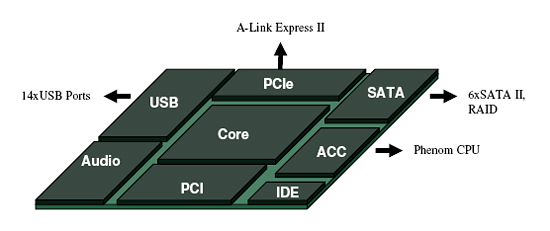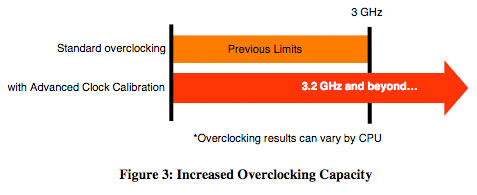SB750 Southbridge

While technically a new part, the SB750 appears to us to be a point upgrade to the SB700. However, it is a major improvement over the SB600. Anyway, let’s get into what has changed and what has not.
The SB700/750 features six SATA 3.0Gb/s ports, up from four on the SB600, with the ability to reserve up to two of those ports for eSATA connectivity. AHCI performance and setup is much easier now and we have not experienced the same problems that plagued the SB600. Drives can be set up in RAID 0, 1, or 10 and RAID 5 now makes its appearance in the SB750. RAID 5 works well for a host based controller and even outperforms the ICH10R in early testing with a three drive array, but four or more drives is resulting in some odd behavior that we are trying to figure out now.
Still missing in action is a native interface for networking support. AMD continues to use an external PHY and MAC for network operations. Although performance is similar to the NVIDIA and Intel solutions, this setup does incur a cost penalty for the motherboard suppliers.
The major improvement in the SB700/750 series over the SB600 is the increase in USB 2.0 performance and the number of ports available. The new dual-channel controller features 12 USB 2.0 capable ports and 2 specific 1.1 ports for compatibility reasons. USB 2.0 performance is up to par with the Intel and NVIDIA solutions.
A single PATA channel provides native IDE support for up to two drives. This channel supports PIO, multi-word DMA, and Ultra DMA 33/66/100/133. Six PCI lanes are still included although we doubt a board manufacturer is going to offer that many. AMD dropped HyperFlash support on the SB700 to make way for the new Advanced Clock Calibration interface.
The SB700/SB750 features four PCI Express lanes for the A-Link Express II interconnect between the Northbridge and Southbridge, but like the current 790FX/780G series, those four lanes are based on PCI Express 1.1 specifications. That means the interconnect bandwidth is capped at 2GB/s, half of what it would be in a PCI Express 2.0 configuration.
Finally, we have the High Definition Audio controller carried over from the SB700 that allows up to 16 channels of audio output per stream. The controller supports up to four codecs with sample rates reaching 192kHz at up to 32-bits per sample.
ACC-

The most drastic and perhaps most important change on the SB750 is the new Advanced Clock Calibration interface that promises additional overclocking headroom or lower voltages with the Phenom processor series, especially the BE products. We have seen clock improvements ranging from 100MHz to over 500MHz depending on the processor we utilized.
The SB750 now has a direct 6-pin interface to the AM2+ socket on the motherboard, there are now pins on the Phenom CPU that connect directly to the SB750. These pins were previously unused and are now used as a means of communication between the South Bridge and the CPU. The SB750, in combination with an updated BIOS, can now override some of the CPU's internal settings which can potentially increase the overclocking headroom of the chip.
AMD says that the settings tweak doesn't impact performance and doesn't change thermals or voltages, it simply can allow a Phenom processor to clock higher when overclocking. The BIOS exposes the parameter being changed, which AMD refers to as the Advanced Clock Calibration (ACC) value. Typically this value has a range of -2 to 0, on motherboards with the SB750 that support ACC the value can be set from -12 to +12. Higher numbers should allow for higher clock speeds, while lower values should allow for lower voltages/lower power operation.
Even after a full press court for the last three weeks, AMD will not tell us what this value actually adjusts - simply stating that it makes it easier for the CPU to run at higher speeds. Based on AMD's careful choice of words, it would seem that adjusting the ACC somehow changes the acceptable margins of operation for the CPU cores (the value can be changed on a per-core basis in AOD or BIOS). By loosening these margins, however it is able to do so; the SB750 + ACC combo can enable many Phenom processors to operate outside of their normal overclocking margins. In fact, AMD is confident enough about the technology that they are willing to state publicly that on average; a 100MHz to 300MHz increase in clock speeds is attainable by the user after some tweaking. In fact, we totally agree with these numbers after extensive testing.
The SB750/ACC trick doesn't work on anything other than Phenom processors, and it works particularly well on the Black Edition processors. While AMD didn't rule out eventually enabling this on K8 based cores, it is a Phenom-only option for now. Reaching higher clock speeds is more of a top priority for Phenom, and it's unclear whether or not whatever AMD is doing here can even work on K8 if they tried.
AMD also committed to enabling similar tweaks for upcoming 45nm based Phenom parts, implying that this was not a short-term solution to the clock speed problem. At the same time, AMD implied that the tweaks that the SB750/ACC feature enables could be incorporated into the manufacturing chain and actually implemented in hardware.
Microprocessors are designed to operate in even the most extreme of conditions, AMD seemed to imply that its ability to adjust the ACC value somehow changes this. Curiously enough, AMD cited "competitive concerns" as a reason why it would not disclose exactly what's going on with this new overclocking feature. We still cannot help but wonder if it is because AMD is going a little too far in the sacrifices, it is willing to make in the quest for higher clock speeds.










39 Comments
View All Comments
Selbatrim - Wednesday, October 8, 2008 - link
Guys.Why is it that no review sites are doing a proper review of the 790GX motherboards? Maybe in particular finding out about hybrid crossfire, the DFI LanParty JR 790GX-M2RS which has crossfire on an mATX board.
I see people wanting reviews of this and the 4550 and 4350s. Why not include some crossfire on the 4550 and 4350? Think differently and let us have an interesting review that doesn't just include the same old stuff. Is 3 way crossfire with the onboard 3300 and 2 discrete cards even possible? Could be GREAT for a small low PSU box...
But at LEAST follow up your preview with a full review! Some of us stupid AMD fanbois have had precious little good news in the CPU and chipset department and the 750 southbridge might just have something interesting to offer! I want testing!!! GIVE ME REVIEWS!!!
*end rant*
MikeODanyurs - Wednesday, September 24, 2008 - link
No kidding, it's almost 2 months now since the preliminary review and still waiting...computerfarmer - Tuesday, September 23, 2008 - link
Gary Wrote, September 10, 2008An update, DFI decided to proceed forward with their uATX 790GX board. My retail kit arrived today and I will be testing it shortly. Also, based on your comments and others I will show a 4870x2 vs 4870 CF on this platform and compare it to 790FX. The roundup should be up late next week, G45 is up on Monday with 790GX/780G/GF8300/NF750a comparison results.
Sincerely,
Gary
This review is late.
computerfarmer - Tuesday, September 23, 2008 - link
Perhaps we are waiting for Intel to see AMD.I(we) have been waiting since August 6th for this review.
MikeODanyurs - Thursday, September 18, 2008 - link
I take it the finished article should be out tomorrow?computerfarmer - Wednesday, September 3, 2008 - link
I have written to Gary about the upcoming article. Gary has said it is coming, perhaps by the 15th of September. From the email I received, it sounds like it is worth waiting for. This will include several motherboards with the same ChipSets, other comparisons may be there as well. This will include RAID5Updated BIOS and Drivers will be part of this article.
Now we have time line.
Thank you Gary
computerfarmer - Wednesday, September 3, 2008 - link
It has been since August 6 since AnandTech first published an article on 790GX/SB750 from AMD. Certain remarks have been made about the products and the proof has been promised, but not delivered.This is the second time in a row this has been done to an AMD motherboard chipset.
Trust is built on promises delivered. AnandTech is not delivering and is not saying why.
It is now September 3rd
Yangorang - Saturday, August 30, 2008 - link
Hey I have a friend that wants to build a super HTPC with the 790GX and RAID5 5 X 750GB hard drives. Troubles with 4+ drives in RAID5 were mentioned in the article. Were they serious issues at all? Please elaborate.MikeODanyurs - Saturday, August 23, 2008 - link
Final review please????mpjesse - Thursday, August 28, 2008 - link
Going on 3 weeks now... nice.